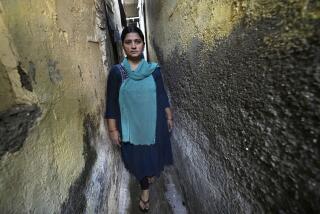Dreams of a better life unravel
- Share via
COIMBATORE, INDIA — The trouble began far away from the leaky concrete house and stand of banana trees that Sakunthala Radhakrishnan calls home.
In 19 years as a textile worker in southern India, Radhakrishnan saved enough to buy gold jewelry.
She sent money to her parents and fattened up her skinny daughter with fancy energy drinks. And she secured for her child a gift she herself never received: an English-language education.
But last year, the better life her family was crawling toward was yanked out of reach. After the U.S. financial crisis erupted thousands of miles away, the textile factory where she and her husband worked closed because orders dried up and credit tightened.
“It’s a distant dream since I lost my job,” she said. “I suffer mental depression.”
Radhakrishnan, 34, and her husband found new jobs as day laborers -- she at a smaller textile factory and he as a welder. But their family income has plunged by nearly half, from $160 to $90 a month. Now they could lose their home and have to rely on the government for food.
For years, textile jobs helped tens of millions of Indians like Radhakrishnan clamber onto the bottom rungs of the nation’s fast-expanding middle class. Textiles are India’s second-largest source of employment, after agriculture, accounting for more than 35 million jobs -- far more than the 2.2 million in India’s high-profile information technology sector.
Now the global economic meltdown is pushing Radhakrishnan and many others backward.
The International Monetary Fund estimates that the slowdown has already driven more than 50 million people globally into extreme poverty. In India, slowing growth means at least 3 million people won’t be lifted out of poverty this year, and some of the 200 million who live just above the official poverty line could slip below it, according to the U.N. Development Program.
Experts warn the social damage could be long-lasting, as parents scrimp on medical care and pull their children from school.
“This will affect a generation,” said Ajay Chhibber, assistant secretary-general of the U.N. Development Program in New York. “A girl who drops out of school will be an illiterate mother the rest of her life. . . . You had a financial crisis. It’s now become an economic crisis. The next phase of this in 2009 will be a social crisis.”
Many in the textile belt of southern India’s Tamil Nadu state have seen their incomes roughly halved, to about $1.50 a day, as factories hit by declining exports and tight credit cut production, slash payrolls and eventually close down. Distribution of government-subsidized food in the area has shot up, and people are taking out loans and hocking jewelry to meet expenses.
India’s public schools are notoriously poor, and many parents work hard to send their children to low-cost private schools that teach English. Now they are pulling them out, cutting off the next generation from what has been the surest ticket to a better life in India: the English language.
During the boom years, textile factories in Tamil Nadu’s Coimbatore region couldn’t get enough workers. They sent buses to nearby villages, picking up people for shifts. In 2005, mills began holding recruitment fairs hundreds of miles away, in Tamil Nadu’s impoverished south. Laborers poured in from poor states like Bihar and Orissa. Even on $3 or $4 a day, many were able to build houses and enroll their children in English-language schools.
Today many of the factory buses have stopped running, and migrants have gone home.
Things started to go bad in 2007, when the rupee appreciated sharply. Next, because of severe power shortages, blackouts began sweeping Tamil Nadu. Factory owners say they still are without power for as much as eight hours a day.
From 2004 to 2007, textile production in India grew an average of 9.4% a year, according to the Confederation of Indian Textile Industry, a trade group. Growth then slipped to 4.9%, and in the year ended in March, production contracted by 0.3%.
The biggest blow was the global financial crisis, which dried up credit and forced American consumers to cut back. Half of India’s textile production is for export, and the U.S. is India’s largest market, accounting for more than 20% of exports. In the first two months of this year, textile imports from India were 11.9% lower than a year ago, according to the U.S. Commerce Department.
Declining demand has tightened an already competitive market. Indian companies say they are at a disadvantage to poorer nations like Bangladesh, which get preferential trade treatment from developed countries.
And there’s no way that India, where just 3% of textiles are made at large mills, can compete with China. China accounted for 35.9% of U.S. textile imports in the year ending in March, compared with India’s 5.4%, according to the Commerce Department.
In the last three months of 2008, 27 of India’s largest textile companies reported an aggregate loss of $14.8 million, compared with a profit of $43.1 million in the same period of 2007, according to data compiled by the Southern India Mills’ Assn.
Today, most textile factories around Coimbatore -- 150 miles southwest of Bangalore-- are operating at half-capacity, say factory owners and business groups.
The Palladam Hi-Tech Weaving Park, a $13-million export center inaugurated in April 2008, is a ghost town. Only 27 of the 92 lime-yellow factory sheds actually opened, and just 14 are operational, said M. Senthilkumar, managing director of BKS Textiles, which owns five units in the park. The rest stand empty, their shutters closed.
Dormitories to house 3,000 workers have been abandoned, half-finished. The only sound on the park’s Main Street is wind.
A few miles away, Gangotri Apparels opened a $68-million factory in 2007. Hulking rooms inside the 52-acre complex are empty. Half the machines are still. Faced with a cash crunch, the company recently managed to restructure its loans and defer interest payments for a year.
Mayank Tibrewal, general manager of operations and son of one of the founders, says the expansion was ill-timed. The fate of his company now hinges on the success of President Obama’s stimulus plans, he said.
“We are all praying that it works,” he said. “Everything is led by the U.S.”
No good data exist on job losses in India’s largely unorganized textile sector, but the Confederation of Indian Textile Industry estimates that a million workers lost their jobs in the year ending March 31. Some have found other work, such as selling fruit or milk, farming or factory day labor. But two dozen textile workers interviewed recently who had lost or changed jobs said their incomes had dropped significantly.
Food is a growing problem. The retail price of rice alone was 60% higher in January than it was two years ago.
Tamil Nadu offers residents subsidized rice at about a penny a pound, as well as cheap sugar, tea, salt, kerosene and dal, or lentils, a staple of the Indian diet. This year, the state allocated $560 million for food subsidies, up 43.6% from last year, helping to push the state’s fiscal deficit to an expected $2.4 billion.
Locals generally dislike the government-subsidized rice, sniffing at its poor quality as they rub the large grains in their fingers. They say the rice is slow-cooking, foul-tasting and smelly.
These days they eat it anyway.
Like many others, Radhakrishnan said that without government rations, her family would be down to two meals a day.
Rice distribution at the food center closest to her house nearly doubled in the first three months of the year, to 71.6 tons a month, said Palanisamy Tirumurthy, who works the counter.
“It’s due to unemployment,” he said. “The majority of them are mill workers and farmers.”
Employees at two other government food centers in the region said distribution had gone up 65% to 70% in recent months.
Radhakrishnan has other problems. Her husband got sick, and she had to sell a gold necklace to pay the doctor’s bill.
Then the couple borrowed $200 from a moneylender at 24% interest to pay their daughter Nandhini’s tuition at an English-language school.
“I want her to become an engineer,” she said. “Definitely not this textile work.”
The local government school, she said, is overcrowded and has poor teachers. Besides, classes are taught in Tamil and she wants Nandhini to learn English.
She pushed the girl forward, urging her to declare her favorite subject.
“English,” said Nandhini, a slim, shy 8-year-old. Then she sang a short, lisping song about butterflies she’d learned in class.
The principals of three private English-language schools in the area say dozens of children have already been pulled out because their parents can no longer afford the fees.
So far, Radhakrishnan and her husband have made only two of six monthly payments on their loan.
And if they can’t repay it?
Radhakrishnan doesn’t want to answer.
On the far wall is a photo of her father-in-law, a silver-haired man with a sweeping mustache who built this house with his own hands 40 years ago.
Her face goes blank for a second.
“We lose this house,” she said.
More to Read
Sign up for Essential California
The most important California stories and recommendations in your inbox every morning.
You may occasionally receive promotional content from the Los Angeles Times.













